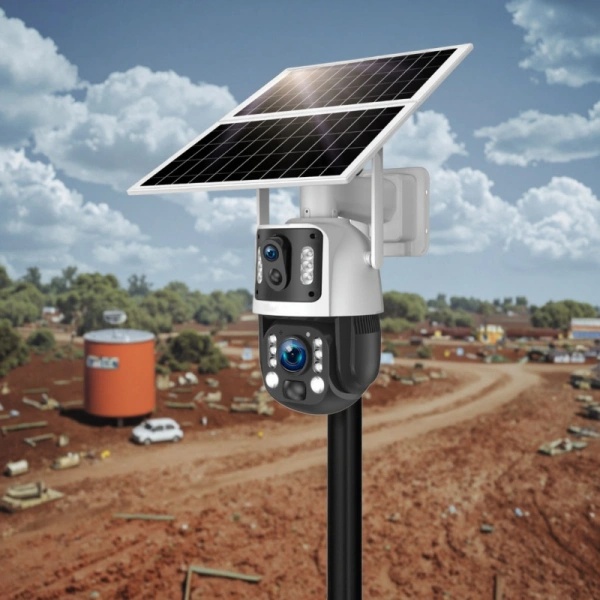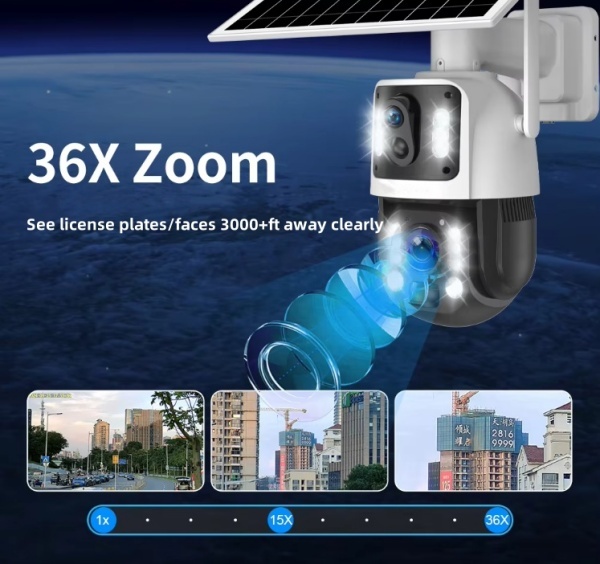Need to Capture Faces & License Plates at 3,000FT? SDL500’s 36X Optical Zoom Can!
Yes — the SDL500’s 36X motorized optical zoom combined with its optical quality, stabilization best practices and correct deployment can capture license plates and facial detail at long distances (up to ~3,000 ft / ~914 m) under ideal conditions. This article explains what “ideal conditions” mean, what affects recognition, and exactly how to deploy SDL500 for best results.
Why SDL500 is built for long‑range evidence capture
- 36X motorized optical zoom: true optical magnification keeps details sharp when you zoom — not digital zoom.
- Dual 3MP lenses (2560×1440 + 2560×1440): telephoto + wide coverage for detection then inspection.
- Foldable 20W monocrystalline solar (2×10W) + built‑in 20800mAh battery with BMS: long off‑grid runtime and low maintenance.
- Ultra‑low standby (0.003W), 0.2s wake-up and PIR + AI human‑shape detection reduce unnecessary power drain and false alerts.
- 4G connectivity, cloud & local storage and two‑way audio complete remote evidence capture workflows.
How 36X optical zoom helps you actually read plates and faces at distance
- Optical zoom increases the image projection on the sensor without losing native sensor resolution — this improves pixel density on the target after zoom, which is necessary for plate/face recognition.
- But readable detail is a function of:
- optical magnification (36X),
- sensor resolution (3MP),
- lens quality and focus,
- atmosphere (heat shimmer, dust, fog),
- target size and orientation,
- camera stability and mounting,
- exposure and lighting (day vs night).
- In clear atmospheric conditions with stable mounting and careful focusing, a 36X optical lens on a 3MP sensor produces sufficient pixel detail to read a license plate or discern facial features at long distances up to around 3,000 ft.
What “3,000FT recognition” actually requires — realistic caveats
- Ideal = clear air (no heavy fog/rain/dust), stable mount, static or slow‑moving target, correct focal lock, and good lighting (or white‑light night mode).
- Not ideal = heat shimmer (midday on hot roads), heavy precipitation, strong crosswind vibration, or fast moving vehicles — recognition degrades in these cases.
- Recommendation: treat “3,000 ft” as an achievable target under controlled conditions, not an unconditional guarantee in all weather and angles.
Field checklist — how to maximize recognition at 3,000 ft
- Mount & stabilize:
- Use a rigid pole or bracket and vibration‑damping fasteners. Minimize sway; even small motion at long range destroys clarity.
- Focus & calibration:
- During commissioning, aim at known targets at similar distances and perform focus/zoom calibration. Save PTZ presets on targets.
- Avoid heat shimmer:
- Prefer early morning or late afternoon for baseline testing. If midday monitoring is required, consider multiple overlapping cameras at different angles.
- Optimize lighting:
- For night recognition, use white‑light mode (80m white LED) when visibility and legality permit. IR mode is covert but loses color detail.
- Presets & patrols:
- Configure PTZ presets and auto patrols for common access routes so the camera dwell time is focused on likely target lanes.
- Multi‑camera strategy:
- For critical assets, use an approach line with two cameras at different locations to improve plate capture angles and verification.
- Test and log:
- Run test drives/walks and save sample clips. Use these to tune AI & PIR thresholds in the app.
Power & uptime: how SDL500 supports long deployments
- Foldable 20W (2×10W) monocrystalline solar panel — space‑saving foldable design reduces shipping volume and allows flexible mounting where sunlight is best.
- Built‑in 20800mAh battery (8×18650) with integrated BMS: safe charge/discharge and long cycle life.
- Ultra‑low standby (0.003W) and quick wake (0.2s) let the system sleep most of the time and only wake for PIR events or scheduled checks, greatly extending runtime.
- Real-world note: manufacturer estimates up to ~360 days standby under very low activity and adequate solar recharge. Actual runtime depends on trigger frequency, uploads, night lighting use and local insolation. For long rainy seasons, add panel area or backup battery.
Detection, recording & data management
- PIR + AI human‑shape detection: PIR wakes the camera with tiny power draw; AI reduces false alarms so uploads are focused and data costs minimized.
- Dual recording modes: choose continuous 7×24 recording or event‑triggered recording via the app (use dual mode to have local circular recording + cloud incident backup).
- Storage: local TF card up to 128GB (loop) and alarm-triggered cloud storage (recommended for theft risk — footage is safe even if device taken).
- 4G & compression: H.265 reduces bitrate for efficient 4G uploads; plan a data package for frequent event uploads or remote live view.
Imaging & night capture recommendations
- Day: rely on optical zoom and focus once targets identified. Use PTZ presets to reduce time-to-target.
- Night: white‑light mode (80m) gives color detail (better for forensics) but is visible; IR (80m) is covert but monochrome. For plate capture at night you will often need white‑light illumination directed onto the plate area for best pixel clarity.
- Audio: two‑way audio (3W speaker + microphone) is useful for warnings or operator interaction.
Typical applications & real examples
- Mid/small farms: monitor gates and remote feed areas; set camera to patrol fence lines and zoom on detected vehicle.
- Construction sites: place SDL500 on high mast to monitor entrance roads and deliverable lanes for plate capture.
- Islands & oilfield pads: separate panel placement for best sun exposure; use cloud storage for critical incident preservation.
- Reservoirs & levees: monitor access roads where long‑range detection is a priority.
Quick technical summary (key specs relevant to long‑range capture)
- Model: SDL500‑4G
- Zoom: 36X motorized optical zoom
- Imaging: Dual 3MP (2560×1440 + 2560×1440)
- Night: Full‑color 0.001 Lux; 80m IR / 80m white light
- Power: Foldable 20W (2×10W) monocrystalline panel; built‑in 20800mAh battery; BMS
- Standby: 0.003W; wake up: 0.2s
- Detection: PIR + AI human‑shape detection; PTZ: H355° × V100°
- Connectivity: 4G options; Android/iOS app; local TF up to 128GB; cloud storage support
- Weather: IP66; −20°C to +60°C
When to choose a higher‑resolution or multi‑camera approach
- If you need guaranteed readable plates/faces at all times (any weather, fast-moving vehicles, constant heat shimmer), upgrade to higher resolution PTZ like SC‑PTZ‑5MP or use overlapping SDL500 placements. See SC‑PTZ‑5MP → https://uboxcam.com/sc-ptz-5mp
FAQ — quick answers
Q: Can SDL500 read a license plate or face at 3,000 ft in rain or fog?
A: No — heavy rain, fog, dust, or heat shimmer will reduce recognition. 3,000 ft is achievable in good visibility and stable mounting; test your site to validate.
Q: Is the foldable solar enough in northern/rainy regions?
A: In long rainy seasons you should add panel area, position the panel for best sun exposure, or add a secondary battery. Use event‑only upload to conserve power.
Q: How do I reduce false alarms?
A: Use PIR + AI human detection, tune sensitivity in the app, set detection zones and schedule active periods.
See full SDL500 specs and buy / request a quote: https://uboxcam.com/sdl500


